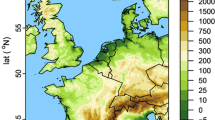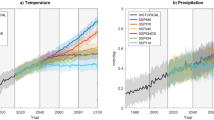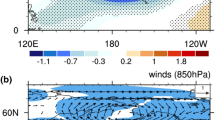Abstract
Based on a single-model 100-member ensemble of climate change simulations performed with the MPI-ESM, this paper investigates how the probability density function (PDF) of atmospheric general circulation (AGC)—a marginal distribution of the full climate PDF—responds to increasing \({\hbox {CO}}_2\) concentration. The investigation provides a first assessment of \({\hbox {CO}}_2\)-induced changes in AGC-PDF derived from ensemble statistics (as oppose to time statistics in usual practice) that arise solely from internal variability consistent with the imposed \({\hbox {CO}}_2\)-forcing. By focusing on the first two moments of the AGC-PDF related to the Hadley circulation and the subtropical jets, we find that the major \({\hbox {CO}}_2\)-induced changes in the PDF are related to structure changes in the mean circulation and in the circulation variability. As \({\hbox {CO}}_2\) concentration increases, different components of the AGC can co-evolve with changing forcing. In particular, the mean Hadley cell co-evolves with the mean subtropical jets. The co-evolution is characterized by the concurrent Hadley cell widening and poleward shifting of the subtropical jets (particularly strong in January), by a strengthening of both the Hadley cell and the subtropical jets in October, and by a weakening of the Hadley cell and a strengthening of the northern and southern jets in January. The changes in circulation variability are more subtle, and reveal only large and spatially coherent changes in places, where the variability is already strong without increasing \({\hbox {CO}}_2\) concentration, such as at the northern and southern flanks of the summer southern subtropical jet, and at the northern flank of the southern polar night jet. There are some significant cross-variabilities between different components of the AGC. Overall, the \({\hbox {CO}}_2\)-induced AGC-changes can be described by linear trends in the first and second moments, with the trends in the means being much stronger than those in the variances and co-variances.

















Similar content being viewed by others
References
Adam O, Grise KM, Staten P, Simpson IR, Davis SM, Davis NA, Waugh DW, Birner T, Ming A (2018) The tropd software package (v1): standardized methods for calculating tropical-width diagnostics. Geosci Model Dev 11:4339–4357
Barnes EA, Polvani L (2013) Response of the midlatitude jets, and of their variability, to increased greenhouse gases in the cmip5 models. J Clim 26(18):7117–7135
Bengtsson L, Hodges KI, Keenlyside N (2009) Will extratropical storms intensify in a warmer climate? J Clim 22(9):2276–2301. https://doi.org/10.1175/2008JCLI2678.1
Chang EKM, Guo Y, Xia X, Zheng M (2013) Storm-track activity in ipcc ar4/cmip3 model simulations. J Clim 26(1):246–260. https://doi.org/10.1175/JCLI-D-11-00707.1
Collins M et al (2013) Long-term climate change: Projections, commitments and irreversibility. In: Stocker T, Qin D, Plattner G, Tignor M, Allen S, Boschung J, Nauel A, Xia Y, Bex V, Midgley P (eds) Climate Change 2013: The physical science basis. Contribution of working group I to the fifth assessment report of the intergovennebtal panel on climate change. Cambridge University Press, Cambridge, New York
Davis N, Birner T (2017) On the discrepancies in tropical belt expansion between reanalyses and climate models and among tropical belt width metrics. J Clim 30(4):1211–1231. https://doi.org/10.1175/JCLI-D-16-0371.1
Emanuel KA (2013) Downscaling cmip5 climate models shows increased tropical cyclone activity over the 21st century. Proc Nat Acad Sci 110(30):12219–12224. https://doi.org/10.1073/pnas.1301293110
Gastineau G, Soden BJ (2009) Model projected changes of extreme wind events in response to global warming. Geophys Res Lett. https://doi.org/10.1029/2009GL037500
Harvey BJ, Shaffrey LC, Woollings TJ, Zappa G, Hodges KI (2012) How large are projected 21st century storm track changes? Geophys Res Lett. https://doi.org/10.1029/2012GL052873
Hasselmann K (1976) Stochastic climate models. Part I Theory Tellus 6:473–485
Hawkins E, Sutton R (2009) The potential to narrow uncertainty in regional climate predictiona. Bull Am Meteorol Soc 90(8):1095–1107. https://doi.org/10.1175/2009BAMS2607.1
Hedemann C, Mauritsen T, Jungclaus J, Marotzke J (2017) The subtle origins of surface-warming hiatuses. Nat Clim Change 7:336–340
Hu Y, Fu Q (2007) Observed poleward expansion of the hadley circulation since 1979. Atmos Chem Phys 7:5229–5236
IPCC AR5 (2013) Contribution of working group i to the fifth assessment report of the intergovernmental panel on climate change. In: Stocker T, Qin D, Plattner G-K, Tignor M, Allen S, Boschung J, Nauels A, Xia Y, Bex V, Midgley P (eds) The physical science basis. Cambridge University Press, Cambridge, New York, p 1535
Jungclaus JH, Fischer N, Haak H, Lohmann K, Marotzke J, Matei D, Mikolajewicz U, Notz D, Storch JS (2013) Characteristics of the ocean simulations in the Max Planck Institute Ocean Model (MPIOM) the ocean component of the MPI-Earth system model. J Adv Model Earth Syst 5:422–446
Knutson TR, Sirutis JJ, Vecchi GA, Garner S, Zhao M, Kim H-S, Bender M, Tuleya RE, Held IM, Villarini G (2013) Dynamical downscaling projections of twenty-first-century atlantic hurricane activity: Cmip3 and cmip5 model-based scenarios. J Clim 26(17):6591–6617. https://doi.org/10.1175/JCLI-D-12-00539.1
Lau WKM, Kim K-M (2015) Robust hadley circulation changes and increasing global dryness due to \({\rm CO}_2\) warming from cmip5 model projections. Natl Acad Sci 112(12):3630–3635
Lorenz EN (1963) Deterministic nonperiodic flow. J Atmos Sci 20(2):130–141
Lu J, Vecchi G, Reichler T (2007) Expansion of the Hadley cell under global warming. Geophys Res Lett. https://doi.org/10.1029/2006GL028443
Mizuta R (2012) Intensification of extratropical cyclones associated with the polar jet change in the cmip5 global warming projections. Geophys Res Lett. https://doi.org/10.1029/2012GL053032
Nguyen H, Lucas C, Evans A, Timbal B (2015) Expansion of the southern hemisphere hadley cell in response to greenhouse gas forcing. J Clim 28(20):8067–8077
Seo K-H, Frierson DMW, Son J-H (2014) A mechanism for future changes in hadley circulation strength in cmip5 climate change simulations. Geophys Res Lett 41(14):5251–5258
Simpson IR, Shaw TA, Seager R (2014) A diagnosis of the seasonally and longitudinally varying midlatitude circulation response to global warming. J Atmos Sci 71(7):2489–2515. https://doi.org/10.1175/JAS-D-13-0325.1
Solomon A, Polvani LM, Waugh D, Davis S (2016) Contrasting upper and lower atmospheric metrics of tropical expansion in the southern hemisphere. Geophys Res Lett 43(19):10,496–10,503. https://doi.org/10.1002/2016GL070917
Stevens B, Giorgetta M, Esch M, Mauritsen T, Crueger T, Rast S, Salzmann M, Schmidt H, Bader J, Block K, Brokopf R, Fast I, Kinne S, Kornblueh L, Lohmann U, Pincus R, Reichler T, Roeckner E (2013) Atmospheric component of the mpi-m earth system model: Echam6. J Adv Model Earth Syst 5(2):146–172
Su H, Jiang JH, Zhai C, Shen TJ, Neelin JD, Stephens GL, Yung YL (2014) Weakening and strengthening structures in the hadley circulation change under global warming and implications for cloud response and climate sensitivity. J Geophys Res Atmos 119(10):5787–5805
Tao L, Hu Y, Liu J (2016) Anthropogenic forcing on the hadley circulation in cmip5 simulations. Clim Dyn 46(9):3337–3350
Vallis GK, Zurita-Gotor P, Cairns C, Kidston J (2014) Response of the large-scale structure of the atmosphere to global warming. Q J R Meteorol Soc 141(690):1479–1501
Villarini G, Vecchi GA (2013) Projected increases in north atlantic tropical cyclone intensity from cmip5 models. J Clim 26(10):3231–3240. https://doi.org/10.1175/JCLI-D-12-00441.1
von Storch H, Zwiers Francis W (1999) Statistical analysis in climate research. Cambridge University Press, Cambridge. https://doi.org/10.1017/CBO9780511612336
Waugh D, Grise K, Seviour J, Davis S, Adam O, Son S-W, Simpson I, Staten P, Maycock A, Ummenhofer C, Birner T, Ming A (2018) Revisiting the relationship among metrics of tropical expansion. J Clim 31:7565–7581
Zappa G, Shaffrey LC, Hodges KI, Sansom PG, Stephenson DB (2013) A multimodel assessment of future projections of north atlantic and european extratropical cyclones in the cmip5 climate models. J Clim 26(16):5846–5862. https://doi.org/10.1175/JCLI-D-12-00573.1
Acknowledgements
The authors thank Jochem Marotzke and Elisa Manzini for their comments. Thanks also to the two anonymous reviewers for their constructive comments. The primary data and scripts used in the analysis that may be useful in reproducing the authors’ work are archived by the Max Planck Institute for meteorology and can be obtained from http://hdl.handle.net/21.11116/0000-0003-FDC1-6.
Author information
Authors and Affiliations
Corresponding author
Additional information
Publisher's Note
Springer Nature remains neutral with regard to jurisdictional claims in published maps and institutional affiliations.
Appendix
Appendix
1.1 Changes in ensemble means and ensemble variances in physical space
The purpose of this appendix is to provide an overview of changes in physical space, regarding both the ensemble mean and the ensemble variability of the AGC and as described by the ensemble mean and ensemble variance of meridional mass stream function and of zonal velocity. Both meridional-height sections of mass stream function and zonal mean zonal wind and horizontal maps of zonal velocity are shown. To describe the changes of the mean and the variability with increasing \({\hbox {CO}}_2\) concentration, the mean and variability at the beginning and the end of the simulation, corresponding to the pre-industrial time and the \({\hbox {4xCO}}_2\)-time, are considered. We included also the absolute trends (instead of t values) of ensemble statistics of circulation indices in Tables 6, 7, 8 (Figs. 16, 17, 18, 19, 20, 21).
Ensemble-means of zonal-mean meridional mass stream function at pre-industrial time (color shadings) and at \(4 \times \mathrm{CO}_2\)-time (black contours) in a January, b April, c July and d October. The scale of black contours corresponds to that of color shadings. The black dotted lines at 500 hPa denote the height, at which Hadley circulation strength \(S_{HC}\) and width \(W_{HC}\) are determined. Unit is 10 Tg/s
Same as Fig. 17, but extending to the upper stratosphere at 1 hPa
Ensemble-means of 2-dimensional zonal wind at 200 hPa at pre-industrial time (color shadings) and at \(4 \times \mathrm{CO}_2\)-time (black contours) in a January and b July. The scale of black contours corresponds to that of color shadings. Unit is m/s. Stippled zonal bands mark areas of the westerlies at 200 hPa. Zonal anomalies within these bands are considered in Fig. 13
Difference in ensemble variance of 200-hPa zonal wind between the \(4 \times \mathrm{CO}_2\)- and the pre-industrial time (\(4 \times \mathrm{CO}_2\) minus pre-industrial time, color shadings), and the ensemble mean of 200-hPa zonal wind in pre-industrial time (black contours), for a January, and b July. Contour interval is 12 m/s
Difference in ensemble variance of 1-hPa zonal wind between the \(4 \times \mathrm{CO}_2\)- and the pre-industrial time (\(4 \times \mathrm{CO}_2\) minus pre-industrial time, color shadings), and the ensemble mean of 200-hPa zonal wind in pre-industrial time (black contours), for a January, and b July. Contour interval is 12 m/s
Rights and permissions
About this article
Cite this article
Reimann, L., von Storch, JS. A phase-space consideration of changing climate-PDF. Clim Dyn 54, 2633–2662 (2020). https://doi.org/10.1007/s00382-020-05130-8
Received:
Accepted:
Published:
Issue Date:
DOI: https://doi.org/10.1007/s00382-020-05130-8










